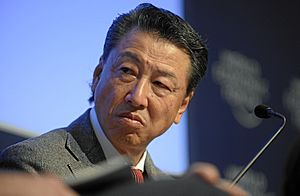Hirotaka Takeuchi facts for kids
Quick facts for kids
Hirotaka Takeuchi
|
|
|---|---|

At the 2009 World Economic Forum, Davos
|
|
| Born | 16 October 1946 |
| Nationality | Japanese |
| Alma mater | International Christian University University of California, Berkeley |
| Known for | Influencing business practices worldwide |
Hirotaka Takeuchi (竹内 弘高) is a well-known professor. He teaches about business strategy at Harvard Business School. He is famous for helping to create ideas that changed how companies develop new products. One of his big ideas helped lead to something called the Scrum framework, which is used a lot in software development today.
Contents
About Hirotaka Takeuchi
Hirotaka Takeuchi was born in 1946. He studied at International Christian University in Tokyo, Japan. Later, he earned two more degrees from the University of California, Berkeley in the United States. Before becoming a professor, he worked for some big companies like McCann-Erickson and McKinsey & Company.
His Teaching Career
Takeuchi started teaching at Harvard Business School in 1976. He was an assistant professor in the Marketing Unit. In 1983, he moved back to Tokyo to teach at Hitotsubashi University. He became a full professor there in 1987. He also returned to Harvard Business School as a visiting professor for a short time in the mid-1990s.
In 1998, he helped start a new business school at Hitotsubashi University. It was called the Graduate School of International Corporate Strategy, and he became its first dean. In 2010, he was named a Professor Emeritus at Hitotsubashi University. This is a special title for retired professors who are still highly respected. In the same year, he also became a professor at Harvard Business School again.
Takeuchi has written many articles for the Harvard Business Review. He has also helped plan events for the World Economic Forum. He serves on the boards of large companies like Mitsui & Co. and Daiwa Securities Group Inc.
The New Product Development Game
Hirotaka Takeuchi worked with a colleague named Ikujiro Nonaka from Hitotsubashi University. Together, they wrote an important article in 1986 called The New New Product Development Game. In this article, they talked about how companies could develop new products faster and more flexibly.
How Companies Innovate
The article looked at how successful companies like Fuji-Xerox, Honda, 3M, and Toyota developed products. They noticed that these companies didn't just follow a step-by-step process. Instead, they used an "overlapping" development process. They compared this to a game of Rugby. In rugby, a team works together, passing the ball back and forth, to move forward as one unit. This is different from older methods where each step had to be finished before the next one could start.
Takeuchi and Nonaka found that the best teams shared three important qualities:
- Autonomy: Teams could organize themselves and make their own decisions about how to do their work.
- Cross-fertilization: Teams had all the different skills they needed to complete a task. People from different areas worked closely together.
- Self-Transcendence: Teams aimed high and pushed themselves beyond what was normally expected. They liked to challenge old ways of doing things.
Impact on Software Development
This article became very important for software development years later. In 1993, a team at Easel Corporation, led by Jeff Sutherland, read the article. They realized its ideas could help them create software on time and within budget.
Sutherland then worked with Ken Schwaber to create the Scrum framework. Scrum is a popular way to manage projects, especially in software development. It helps teams work together in short cycles to deliver products quickly and efficiently.
The Knowledge Creation Model
Takeuchi's colleague, Ikujiro Nonaka, also wrote an article in 1991 called The Knowledge-Creating Company. This article explored two types of knowledge:
- Tacit knowledge: This is knowledge you gain from experience. It's hard to write down, like knowing how to ride a bike.
- Explicit knowledge: This is knowledge that is written down, like in books, manuals, or instructions.
Nonaka explained that Japanese companies were good at turning tacit knowledge into explicit knowledge and back again. He called this the "spiral of knowledge."
In 1995, Nonaka and Takeuchi wrote a book together that expanded on these ideas. It was called The Knowledge-Creating Company: How Japanese Companies Create the Dynamics of Innovation. The book showed how successful Japanese companies created new ideas and used them to make great products. They called this "organizational knowledge creation." It's about how a company can create new knowledge, share it with everyone, and use it to make new products, services, or systems.
This book was recognized as the Best Book of the Year in Business and Management in 1996 by the Association of American Publishers.
See also
 In Spanish: Hirotaka Takeuchi para niños
In Spanish: Hirotaka Takeuchi para niños
- SECI model of knowledge dimensions

